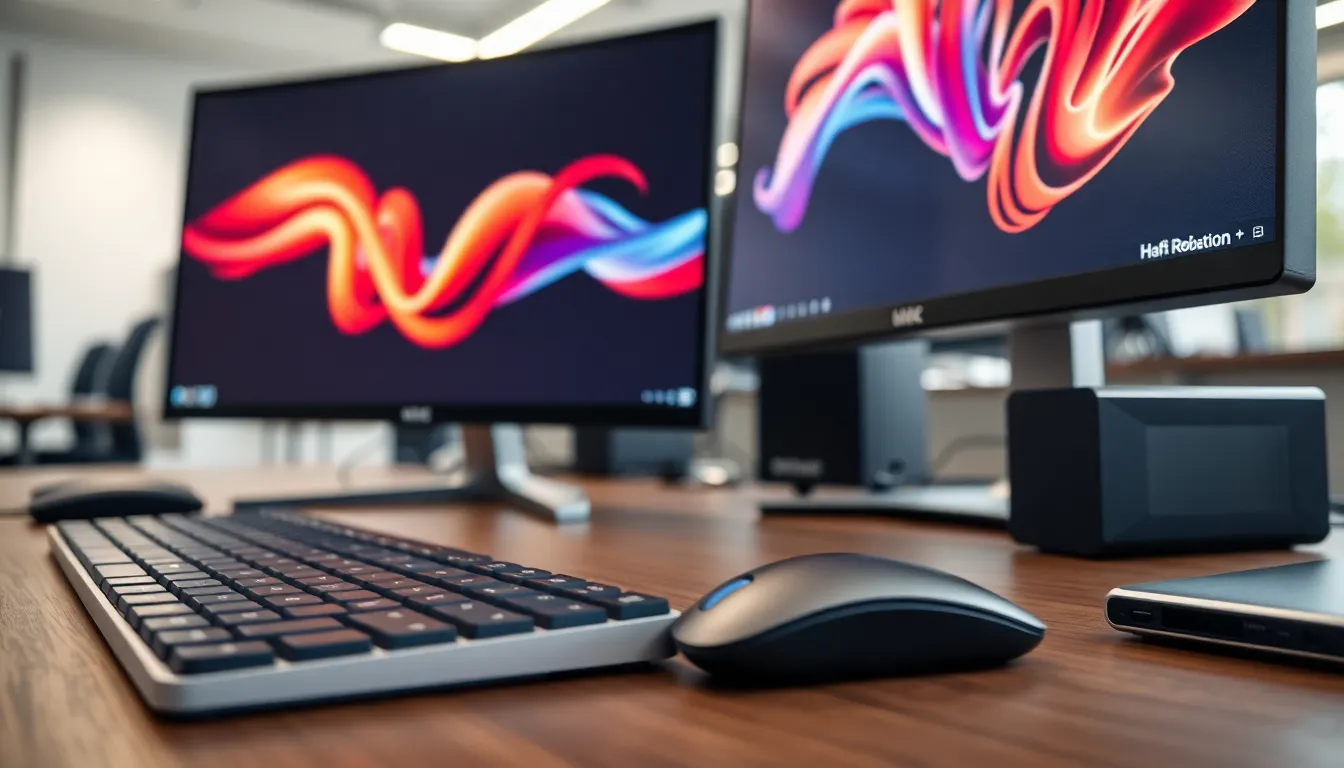Table of Contents
ToggleIn a world where technology reigns supreme, understanding the basics of computer hardware is like knowing the secret handshake to the digital club. Whether you’re a tech novice or a self-proclaimed computer whiz, grasping what constitutes hardware can save you from awkward conversations and tech mishaps. Spoiler alert: your cat’s not hardware, no matter how many times it sits on your keyboard!
Definition of Computer Hardware
Computer hardware refers to the physical components that constitute a computer system. Components such as the central processing unit (CPU), memory, storage devices like hard drives, and input/output devices form hardware. It encompasses anything that has a tangible form and is essential for a computer’s operation.
Examples include monitors, keyboards, and printers. Each device connects directly to the computer, enabling functionality and interaction. The motherboard serves as a critical hub, linking various hardware parts, and facilitating communication between them.
Hardware distinguishes itself from software, which consists of programs and applications that operate within the hardware framework. Unlike software, hardware requires physical space and can degrade over time. Understanding the distinction between these two aspects is vital for troubleshooting and upgrading systems.
Functions of hardware range from simple tasks like displaying information to complex computations essential for running advanced applications. Components work together in harmony to deliver a seamless user experience. Identification and understanding of these physical elements lead to better technical decisions and informed upgrades.
Types of Computer Hardware

Computer hardware encompasses various devices that enable computers to perform their functions. Key categories include input devices, output devices, storage devices, and processing units.
Input Devices
Input devices allow users to interact with a computer. Common examples include keyboards, mice, and scanners. Keyboards provide a mechanism for typing text, while mice facilitate navigation on a graphical interface. Scanners convert physical documents into digital format. Touch screens offer an additional interactive element, allowing direct input through touch. Each device serves a specific purpose that enhances user experience and efficiency.
Output Devices
Output devices deliver information from a computer to the user. Monitors and printers represent the most familiar forms of output. Monitors display visual data, while printers produce hard copies of documents and images. Speakers and headphones offer auditory output, making multimedia applications more engaging. Projectors provide large-scale display capabilities for presentations. Each of these devices translates computer data into a human-readable form.
Storage Devices
Storage devices are essential for saving and retrieving data. Hard disk drives (HDD) and solid-state drives (SSD) are primary choices in modern computers. HDDs use magnetic storage to hold data, while SSDs utilize flash memory for faster access speeds. USB flash drives and external hard drives offer portable options for data transfer. Cloud storage solutions provide online data management and backup capabilities. Each storage solution presents unique advantages in speed, capacity, and accessibility.
Processing Units
Processing units perform the essential computations and operations within a computer. The central processing unit (CPU) acts as the brain, executing instructions and managing tasks. Graphics processing units (GPU) enhance multimedia processing, improving visuals for gaming and graphic design. Specialized processors, such as digital signal processors (DSP), handle specific tasks, such as audio processing. Each processing unit plays a critical role in the overall performance and efficiency of the hardware system.
Examples of Computer Hardware
Computer hardware encompasses various components that are essential to a computer system’s functionality. It includes both peripheral devices and internal components, each serving specific roles.
Peripheral Devices
Peripheral devices enhance user interaction with a computer. Key examples include keyboards, which allow data entry, and mice, which facilitate navigation. Printers produce physical copies of documents and images, while scanners convert printed materials into digital formats. External storage drives, like USB flash drives, provide additional space for data backup, enhancing accessibility and portability. These devices connect through ports, ensuring seamless communication with the main computer system.
Internal Components
Internal components form the backbone of computer hardware. The central processing unit (CPU) executes instructions and performs calculations, acting as the brain of the computer. Memory, specifically RAM, temporarily stores data for quick access during operations. Storage devices like hard disk drives (HDD) and solid-state drives (SSD) retain information over time, with SSDs offering faster data retrieval. The motherboard serves as the crucial hub, linking these components and enabling effective data transfer, ultimately defining the computer’s performance and capabilities.
Common Misconceptions
Many individuals confuse hardware with software, leading to significant misunderstandings. Hardware represents the physical components of a computer, which contrasts sharply with the intangible nature of software that facilitates operations. A common belief suggests that all electronic devices qualify as hardware, but this is not accurate; only devices directly integral to a computer system meet this criterion.
Some view peripherals exclusively as hardware, overlooking internal components like CPUs and RAM. Peripherals serve important functions, yet internal components are equally vital for system performance. A misconception exists that any external connection, such as a USB drive, classifies as hardware; however, its categorization depends on its role within the computer environment.
Another myth states the longevity of hardware remains guaranteed, while in reality, components like hard drives and power supplies can fail over time. Misunderstanding lifespan can lead to unexpected data loss or system failures. Users often think upgrading hardware involves only adding components, ignoring the technical requirements for compatibility and installation.
Recognizing that both modern and older devices can serve as hardware is essential. Components such as graphics cards and sound cards demonstrate this principle, as they evolve but continue to play critical roles in system functionality. Users should remember that effective troubleshooting requires knowing how to differentiate between hardware types and their functions. This knowledge aids in optimizing a computer’s performance and troubleshooting efficiently.
Understanding computer hardware is vital in navigating today’s tech landscape. Recognizing the difference between hardware and software can prevent confusion and enhance troubleshooting skills. By familiarizing oneself with various components like input and output devices as well as internal parts, users can make informed decisions about upgrades and maintenance.
This knowledge not only improves performance but also helps in maximizing the overall efficiency of computer systems. As technology continues to evolve, staying updated on hardware developments remains crucial for both casual users and tech enthusiasts alike.










